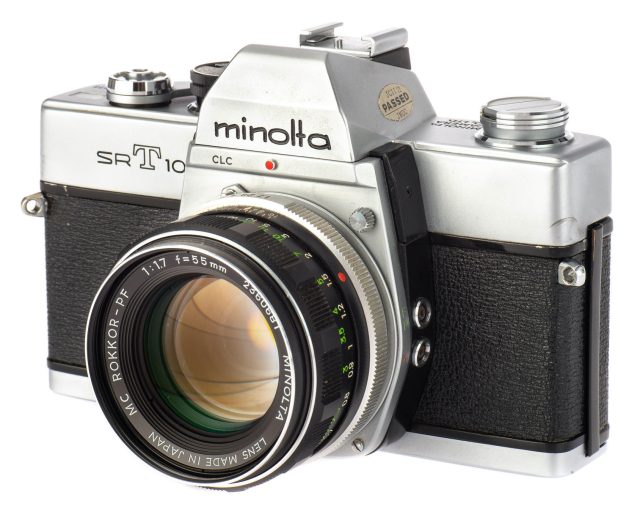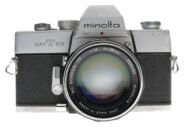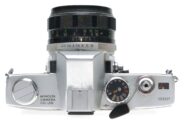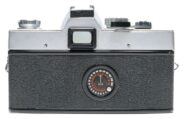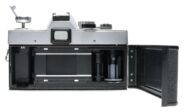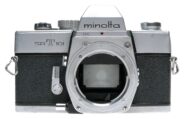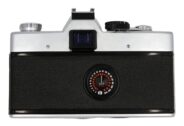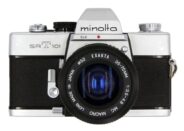Announced
Production status
System
Minolta SR system cameras
- Minolta SR-1
- Minolta SR-1s
- Minolta SR-2
- Minolta SR-3
- Minolta SR-7
- Minolta SRM
- Minolta SRT100
- Minolta SRT101
- Minolta SRT102
- Minolta SRT200
- Minolta SRT200 (II)
- Minolta SRT201
- Minolta SRT201 (II)
- Minolta SRT202
- Minolta SRT202 (II)
- Minolta SRTMC
- Minolta SRTMC-II
- Minolta SRTSC
- Minolta SRTSC-II
- Minolta X-370
- Minolta X-370N
- Minolta X-370s
- Minolta X-570
- Minolta X-600
- Minolta X-7
- Minolta X-700
- Minolta X-7A
- Minolta X-9
- Minolta XD-S
- Minolta XD11
- Minolta XD5
- Minolta XE
- Minolta XE-5
- Minolta XG 9
- Minolta XG-1
- Minolta XG-1(n)
- Minolta XG-A
- Minolta XG-M
- Minolta XG-SE
- Minolta XG7
- Minolta XK
- Minolta XK MOTOR
Minolta SRT101
35mm MF film SLR camera • Discontinued
Specification
| Format: | |
| 35mm full frame | |
Film type: | 135 cartridge-loaded film |
| Minolta SR [43.5mm] | |
| Shutter: | |
Type: | Focal-plane |
Model: | Mechanical |
Speeds: | 1 - 1/1000 + B |
| Exposure: | |
Exposure metering: | Through-the-lens (TTL), open-aperture |
Exposure modes: | Manual |
| Physical characteristics: | |
Weight: | 705g |
Dimensions: | 145x94.5x47.5mm |
Manufacturer description #1
Measuring exposure through the lens isn't new. What is new is doing so with unfailing accuracy, regardless of contrast between subject and background. This is what makes the Minolta SR-T 101 far more than a new 35mm single lens reflex with through-the-lens metering... and so practical in unusual lighting situations.
Exclusive "CLC" exposure measurement system. "CLC" stands for Contrast Light Compensator, a remarkable development that enables the Minolta SR-T 101 to achieve accuracy never before possible in a through-the-lens metering camera.
In the "CLC" system, two extremely sensitive cadmium sulphide cells are arranged in a unique "series" circuit that causes each cell to be influenced by the other. Instead of an "average" reading, which is based on equal measurement of light and dark areas, you get an adjusted reading that makes special allowance for the predominant area.
Thus, in high contrast or uneven light sitiations, "CLC" automatically compensates to prevent under-exposure of the darker area. And "CLC" achieves this unprecedented accuracy while reading the entire picture area... unlike "spot" systems which cover only a small part of the scene.
Maximum handling ease and speed. An exclusive viewfinder design permits composing, focusing, setting aperture and shutter speed without ever taking the Minolta SR-T 101 from your eye... and always at full aperture.
Correct exposure, based on through-the-lens measurement, is set as you align two indicators in the finder. Shutter speeds are shown on a scale in the viewfinder... but outside of the picture area. A fine microprism center spot permits critical focusing. Corner-to-corner brightness is unmatched by any other 35mm reflex.
Exposure is measured at maximum aperture. The Meter Coupled (MC) Rokkor 58mm f/1.4 lens stays at full aperture except during the instant of exposure. Only then does the diaphragm "close down" automatically to pre-set aperture... re-opening automatically for the next exposure. The finder is always at maximum brightness, regardless of aperture needed to obtain proper exposure. The same automatic diaphragm control is provided by six other new MC Rokkor lenses, from 28mm wide angle to 200mm telephoto.
A system of lenses and accessories. In addition to the new "MC" lenses, the Minolta SR-T 101 will accept any of the complete system of interchangeable Rokkor lenses. These include focal lengths from 18mm ultra-wide-angle to 1000mm super-telephoto, plus special optics for macro and zoom photography. Over 100 accessories provide virtually unlimited flexibility.
The Minolta SR-T 101 has everything you would expect in a fine 35mm reflex... and more. There is an instant-return mirror... oversized to eliminate vignetting with long lenses... and an independent mirror lock. Shutter speeds are from 1 to 1/1000th sec. plus Bulb, with X synch. at 1/60th sec. and FP synch. at all speeds. The film advance is geared and "offset" for rapid shooting. The ASA range, from 6 to 6,400, is wider than on any other through-the-lens metering camera. There are many more refinements too numerous to list.
Manufacturer description #2
THE TOTAL PERFORMANCE SLR CAMERA
The Minolta SR-T 101 is a 35mm camera not confined in any way by the limitations of most comparably priced through-the-Iens metering cameras. It incorporates every single feature necessary to the success of the accomplished photographer. It has many others unique to any single lens reflex camera you can buy today. Designed and built by experts who know precisely what a camera must accomplish to satisfy the thinking professional, the SR-T 101 is the total performance SLR.
As a versatile instrument for the serious photographer, the SLR camera with through-the-Iens light measuring and full complement of interchangeable lenses has no peer. The SR-T 101 is all this - and then some. Its through-the-Iens system is of the full-aperture measuring type, a method of determining correct exposure long favored and respected by professionals and amateurs alike. Moreover, to enhance the SR-T 101's uncommon capability, Minolta has called upon its extensive exposure meter manufacturing experience and created the most accurate means of determining accurate exposure ever built-in to a camera. Called "Contrast Light Compensator," the meter system retains all the advantages of the most precise methods of measuring exposure, yet does away with the majority of their disadvantages. Minolta can prove it.
An abundance of other features marks the SR-T 101 as one of the very few truly professional SLR cameras available at any price. But, above all, the supreme versatility of this camera as a "system" camera remains unaltered. The SR-T 101 accepts almost every Rokkor Lens (including a new and unusually fast 58 mm F1.2 lens) and many other fine Minolta attachments ever built for the SR series of cameras. It is now available with professional black or standard metallic body. And it is, without question, the easiest·to- handle, easiest-to-operate SLR you'll ever photograph with.
EXACT EXPOSURE READING WITH MINOLTA'S MARVELOUS CLC
As in all fine Minolta cameras, the SR-T 101 has many superb functions and mechanisms which have been studied from the viewpoint of the ultimate camera user. One of the more valuable is the new CLC (Contrast Light Compensator) exposure measuring system - most accurate means of determining correct exposure ever built-in to a camera.
Since it performs many useful tasks for the photographer, CLC is necessarily a complicated principle, involving all the technical mumbo-jumbo of photoelectronics, physics and mathematics. But, simply and precisely, CLC is designed to provide unusually accurate through-the lens metering in high-contrast lighting situations, and it does this through a unique system of splitting the light which enters the lens. Remember that, under "normal" lighting circumstances, built-in CdS exposure meters function with remarkable accuracy. The sole catch is that the photographer is faced time and time again with lighting situations that are difficult to calculate. And, invariably, trouble in the form of under- or over-exposure results when he relies on his CdS meter to get a reliable reading in high-contrast light. All too often, he doesn't get it.
But CLC eliminates failures resulting from under-exposure of shadows or other dark areas. It doesn't give a brighter light reading than the real average (like some CdS meters do), nor does it require difficult calculations. It does provide automatic compensation for bright light readings and dark readings. No other through-the-Iens system does.
In the SR-T 101, two CdS cells are located on top of the pentaprism. One is near the exit node; the other directly opposite. These cells are linked electrically in a way that is totally unique to the SR-T 101. By taking simultaneous light readings of the many lighting areas of the photo subject, and by automatically calculating a near-perfect contrast ratio, CLC insures perfect exposure no matter what the lighting condition. At all times you get a sensitive and reliable exposure reading - and your photography is faster and far less complex. You can prove it for yourself by testing the remarkable SR-T 101.
THE VERSATILITY OF WORLD-FAMOUS ROKKOR LENSES
Judged by any standards of photography, the SR-T 101 is an astoundingly capable camera. With its versatile complement of Rokkor Lenses and other fine Minolta accessories, it becomes an instrument capable of challenging - and mastering - any photographic situation imaginable.
More than 120 accessories and attachments may be used with the SR-T 101. Included are more than 30 interchangeable Rokkor Lenses, covering the full range 16mm fisheye ultra-wideangle to 1000mm super-telephoto, and zoom lenses from 50mm to 500mm.
Such is the excellence of Rokkor Lenses that they have earned immense popularity among photographers of all abilities - for the following reasons: Even brightness from corner to corner; superb color reproduction; high resolving power with sharp contrast between image and background; ability to allow photography of objects as they really exist; and convenient mechanisms and ease of handling. Made exclusively by Minolta for Minolta cameras, Rokkor Lenses are quality-controlled from raw materials to final, finished product. They are generally acknowledged to be one of the world's few great systems of photographic optics.
An exclusive feature of Rokkor Lenses is Minolta's patented Achromatic Coating process. This secret treatment is actually a double coating, which results in the famous "green lens" appearance. This double coating allows the entire light spectrum to pass throlJgh the lens. As a result, Rokkor Lenses give true color balance - better than any other lens manufactured today. Minolta guarantees it. And can, because Minolta standards for lens precision and perfection are the highest in the camera industry.
THE MERITS OF MINOLTA'S THROUGH-THE-LENS SYSTEM
The principle of the through-the-Iens light measuring meter is hardly new. But the way Minolta has improved it in the SR-T 101 is new.
In all single lens reflex cameras, a photographer looking through the viewfinder sees the exact light condition and image that he'll ultimately record on film as he releases the shutter. When an ideal through- the-lens system is integrated into the camera, two additional things should occur: the exposure meter should receive as much light as the film surface, and the light receiving angle of the meter should correspond to the view angle of the taking lens.
Such a system has unqualified advantages. With it, the photographer need never worry about exposure factor when he changes lenses as the light receiving angle of this meter compensates for the change in all lenses. And he can do close-up or telephotography without making complex calculations.
The SR-T 101's through-the-Iens system does all this, and adds the benefit of precise exposure measurement with CLC. Its two CdS cells are located at the top of the pentaprism. Light rays brighter than the real average are minimized. Harmful, extraneous light which enters the taking lens is prevented by a light shield plate. Harmful incident light is prevented from entering through the eyepiece by a reflection absorption film and a shading mask.
In addition, the SR-T 101 has a full-aperture measuring system. Its CLC meter is coupled to the aperture and shutter speed setting. Focusing, viewing and exposure measuring is performed simultaneously with the lens open full. The viewfinder is always bright, corner-to-corner.
Minolta incorporated all these through-the-Iens advantages in its SR-T 101 without sacrificing convenience and ease-of-handling. Other through-the-Iens cameras couldn't do it, no matter what their price.
FULL-APERTURE MEASUREMENT
One of the truly important features of any outstanding through-the-lens metering camera, from the professional photographer's viewpoint, is full-aperture measurement. Minolta's SR-T 101 has it.
Keep in mind that on many through-the-lens cameras the visual field of view as you glance through the viewfinder becomes darker when the lens is "stopped down" for exposure measuring. Naturally, this makes accurate focusing, composing and measuring difficult. With the SR-T 101, the MC lens is completely automatic, and aperture is always at maximum opening until you release the shutter. This means even when you set the aperture when measuring exposure, the viewfinder remains at maximum brightness from corner to corner. You see clearly what you're shooting at all times. And focusing, composing and correct exposure measuring, even for a dark subject, is simple - precisely the way you want it to be to get perfect photographic results.
MC Rokkor Lenses are equipped with meter couplers for full-aperture measurement. The CLC meter in the camera is coupled to the aperture and shutter speed setting, and you obtain correct exposure from either setting.
But this entirely new camera does not obsolete the great SR system of Rokkor Lenses. Conventional Rokkor Lenses for the SR series also fit the SR-T 101.
CONTROL-INTEGRATED VIEWFINDER
Whether you're an amateur photographer or a veteran, you'll appreciate the unequalled control- integrated viewfinder of the SR-T 101. It provides more than ample information for any photographic situation other than flash - and you can make ALL necessary adjustments without ever taking your eye from the camera.
PENTAPRISM VIEWFINDER
It provides a near-perfect field of vision. This means you see the subject exactly how it appears to the human eye.
MICROPRISM FOCUSING
The spot of slanted microprisms in the center of the finder snaps the image into crisp sharpness when perfect focus has been achieved. The Fresnel lens keeps the image bright out to each corner, an important factor for precise, easy picture composition.
FOLLOWER-NEEDLE TYPE EXPOSURE MEASURING
The follow-up needle in the SR-T 101 viewfinder is exclusive - and new - with Minolta. With it, you can always determine the entire range of possible exposures at a glance.
SHUTTER SPEED INDICATOR
At the lower part of the viewfinder is a convenient shutter speed indicator. It lets you change from one shutter speed to another without taking the camera from your eye. In fact, no matter what adjustment is necessary to insure perfect photo-taking, you can make it with the SR-T 101 - and your eye always is looking through the viewfinder. Can you think of another SLR camera at any price that has a similar feature?
EASIEST HANDLING THROUGH-THE-LENS CAMERA ON THE MARKET
While it extends your picture-taking capabilities, the SR-T 101 remains the easiest-to-handle through-the-lens SLR camera ever created. So far, nobody has made a more convenient, easier-to-use SLR.
Pick it up. Hold it in picture-taking position. Notice how the sleek, thin body fits easily, gracefully into the curve of your hands. The balance - so important to any camera - is perfect. With the SR-T 101, Minolta proves that professional SLR cameras don't have to be bulky, heavy or hard to handle.
The SR-T 101's full-aperture measurement system contributes to its ease of handling. Remember, cameras which use the stop-down measurement system require a hand-operated device for closing the diaphragm blades. The blades on the SR-T 101 stay wide open until you release the shutter, then they close automatically with Me Rokkor Lenses.
All controls of the SR-T 101 are positioned where you can read them, adjust them at a glance. What's more, with Minolta's new control-integrated viewfinder, you can operate everything - exposure setting, focus, shutter speed, aperture setting and framing - without taking the camera from your eye. There isn't another single lens reflex camera in the entire through-the-Iens field that can match this viewfinder for convenience.
The SR-T 101's easy-handling ability extends all the way to its versatile complement of interchangeable Rokkor Lenses. Each is bayonet-mounted. You can change from one to the other in a matter of seconds, without complicated adjustments.
ADDITIONAL QUALITY FEATURES
OVERSIZED MIRROR
Largest of any found in a SLR camera, the SR-T 101 mirror allows the photographer to view the full frame without annoying mirror cut-off of the image - even when medium to long telephoto lenses and close-up lenses are employed.
VIGNETTING CORRECTION OF THE FULL-APERTURE SCALE
In most camera lenses, the corners of the viewfinder become darker than the center when the aperture is open wide. With SR-T 101 MC Rokkor Lenses, the full aperture scale is given vignetting correction for correct exposure. Accurate exposure measuring is thus possible at the maximum F-stop because these MC lenses compensate the distance between the F-number of the maximum open aperture and the next F-number to it.
RAPID CHANGE LENS MOUNT
All Rokkor Lenses (except close-up types) are bayonet-mounted. This is a quick, foolproof way to change lenses - and you can do it in seconds. At all times, the mount is rigid and smooth, without the slightest trace of looseness or "backlash" And this is an important consideration since rigidity of mount is essential to holding good picture definition. Another point: You can change from one lens to another without making annoying adjustments.
EASY-LOADING SYSTEM
The SR-T 101 take-up film spool lets you load film quickly and safely. If you've ever been in a hurry to load a camera, you'll appreciate this feature.
WIDE RANGE OF FILM SPEEDS
The SR-T 101 accepts film from ASA 6-6400, making it versatile enough for any kind of photography.
WIDE SELECTION OF SHUTTER SPEEDS
Shutter speeds range from 1 to 1/1000 second plus B. All speeds are synchronized for FP bulbs: 1 to 1/60 for electronic flash.
SPECIFICATIONS & ACCESSORIES
Single lens reflex 35mm camera with through-the-lens CLC (Contrast Light Compensator) meter coupled to shutter and film speed. Working range is EV 3 to EV 17 at ASA 100. Standard Rokkor Lens 58mm F1.4 (or 58mm F1.2 or 55mm F1.7). Black or metallic body. Focal plane shutter with speeds from 1 to 1/1000 sec. plus B. Fine microprism focusing with Fresnel lens. Real image finder through the fixed, eye-level pentaprism. Exposure control needle and shutter speed are visible in finder. Flash synchronization (FP and X contact points). Single or several stroke rapid-wind film advance lever. Automatic reset film counter, rapid film-rewind crank, built-in self timer, bayonet type lens mount, accessory shoe. Accepts standard 35mm film (20 or 36 exposures) in ASA speeds 6-6400 (DIN 9-39). Built-in ASA-DIN converting table. Oversized quick return mirror with lock-up device.
